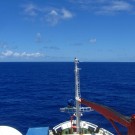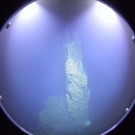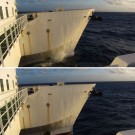While others enjoyed the first week of their summer holidays and probably went to the beach, a bunch of dedicated high school kids from Schleswig-Holstein and other parts of Germany decided to come to Geomar and learn more about rocks, minerals and under water science. Last week, the department of “Magmatic and Hydrothermal Systems” […]
Radio Rock Research
Boom. Every 12 seconds. Boom. You can rather feel than hear the deep sound vibrating through the ship. Boom. – Seismic measurements try to ‘look’ through the seafloor, into the sediments and rocks. They use deep, very low frequency sound of around 6 Hertz, which is noticeable lower than common electric or acoustic bass drums. […]
From R/V Meteor towards the Sun
*a guest entry by Laura Raeke, Max-Planck-Institute for Meteorology, Hamburg* Above surface… While the most scientists on board of the RV Meteor on cruise M127 are interested in seismic and geological processes under the sea(floor) surface, there are also measurements going on in the other direction: above surface, into the sun. The task is, […]
Planning, Planning, Planning
Day 20 without our luggage on board. It will wait for us in Ponta Delgada, our next port. Now, we (11 crew members and scientists) are living with what was on board and what we were able to shop in Bridgetown, Barbados. It is no surprise that the washing machine was the first thing we […]
To the Seafloor and Back
“Bridge for lab. We reached the bottom.” Two clicks in the walky-talky: the confirmation from the bridge. In the lab, on boxes, tables, and even on the floor gather the scientists around the screen, on which fine lines slowly appear, and on which a blue-grey turns into a pale yellow. Dark spots become rocky boulders, […]
1151 nautical miles straight
Heading of 50 degrees. Northeast. Speed of 10 to 11 knots. Calm, blue sea. Now and then, a bird flies by. Nothing has really changed for three days, and it will stay like this for another two days, until we reached our target area, the TAG hydrothermal field. To go there, a plane would need […]
Ahoi from Barbados
Ahoi from Barbados … the place, from where we start our five-week expedition with the German research vessel Meteor. The aim of our adventure is the exploration and investigation of active and inactive hot springs of the TAG hydrothermal field, which lies on the seafloor in the middle of the central Atlantic Ocean; more […]
Live from the seafloor
At the moment, on board research vessel R/V Falkor, colleges are diving with a remotely operated vehicle (ROV) to a hydrothermal vent site in the south western Pacific. A live stream from the seafloor is available here. What they are doing there and why, find out here. —- Im Moment tauchen Kollegen vom Forschungsschiff […]
The Last Line
The ‘TechLab’, where all machines, sensors, and systems on board meet, has been our work station for nearly a month now. In three shifts, each of eight hours, we worked 24/7: watched the sonar systems, launched XBTs at least every six hours, and stored, processed, and gridded several tens (or even hundreds?) of gigabytes of […]
Wind, Waves and Water masses
or ‘How we map, part II’ Have you ever tried to focus your camera on a point at the horizon out of a car driving across bumpy streets? That is basically what the multibeam echosounder system on the Kilo Moana, has to deal with. In order to get a continuous and clear image of […]









